
A coordinated transportation system can better meet a variety of transportation needs more efficiently and effectively and improve the health of older adults by expanding options for transportation to health care providers, healthy foods, and social events that connect them to the community.
But especially in rural areas—where frequently needed destinations like hospitals and shopping centers may be 50 or 100 miles away—it can be challenging for smaller organizations that serve older adults to purchase accessible vehicles equipped with lifts and ramps for mobility aids, as well as allocate the time and staff needed to provide transportation service.
That’s where transportation coordination comes in.
Why is transportation coordination important for older adults?
Transportation is more than just transporting people—it is about people’s ability to get from where they live to the shopping center, doctor, post office, family and friends, etc. Older adults need access to healthy food, high-quality medical care, and meaningful activities and seniors make up a large portion of the population who rely on public and community transportation.1 About 600,000 older adults stop driving each year, according to USAging.2 This population has transportation needs that often interconnect with other factors such as disability, geographic isolation, and limited income. In addition, many older adults rely on mobility aids, such as wheelchairs, walkers, or scooters, depend on caregivers, and need door-to-door (and sometimes even door-through-door) transportation service.
Luckily, transportation coordination is an option for many organizations that want to provide transportation for older adults to work together and leverage the resources that they can all bring to the table. In a coordinated transportation system, combining travel options such as accessible fixed route, ADA complementary paratransit, demand response, volunteer transportation, and shared ride options can open the mobility landscape for those who no longer drive. Multiple entities can work together to provide transportation and share mobility management responsibilities to arrange rides to more fully serve the needs of the community.
However, coordinating transportation may seem daunting, especially to small entities. The process usually involves many steps, including writing or participating in a formal Coordinated Public Transit Human Services Transportation Plan, obtaining funding, vehicles, and staff, and implementing a sustainable, coordinated transportation system and services.
How the Transportation Technical Assistance Coordination Library can help
Since no one wants to start from scratch and reinvent the wheel, the Transportation Technical Assistance Coordination Library (TACL) is available to assist transportation stakeholders with every aspect of coordination. The library features high-quality, peer-reviewed training and technical assistance resources from the Federal Transit Administration (FTA) and its Technical Assistance Centers:
- National Aging and Disability Transportation Center (NADTC)
- National Center for Applied Transit Technology (N-CATT)
- National Center for Mobility Management (NCMM)
- National Rural Transit Assistance Program (National RTAP)
- Shared-Use Mobility Center (SUMC)
- Transit Workforce Center (TWC)
TACL includes learning modules, case studies, webinars, and many other types of resources to help organizations work together to establish and manage coordinated transportation programs in their communities and regions.
By browsing TACL, you can find out about how:
- North Front Range Metropolitan Planning Organization, Partnership for Age-Friendly Communities, and Larimer County’s Office on Aging collaborated to better meet the needs of older adults, people with disabilities and veterans living in the county’s rural areas through Project MILES - Mobility Inclusiveness; Locations Everywhere; Simple (source: NADTC’s Best Practices Compendium)
- Tri-Valley Opportunity Council Rural Transportation coordinated a public transportation and volunteer driver system throughout sparsely populated, very rural, eight-county area in northwest Minnesota that uses a centralized call system and operates transportation services seven days a week (source: Rural Health Information Hub’s Transportation to Support Rural Healthcare)
- Marin Transit and the Transportation Authority of Marin (TAM) partnered to host a suite of mobility programs called Connect2Transit, a Mobility on Demand program providing customers with many options that can supplement their transportation journeys, including same-day, wheelchair accessible rides (source: SUMC’s Integrated Mobility Services with Connect2Transit, Marin County, California)
- The New Hampshire Mobility Management Network, made up of community transportation services provided by volunteer drivers and led by Easter Seals, functions within the State Coordinating Council for Community Transportation, which engages with public and human service transportation providers in their statewide coordination and mobility management efforts (source: NCMM’s Mobility Management: State of the States Report)
In addition to these and many other case studies, TACL provides guidance on how to:
- Write a Coordinated Public Transit Human Services Transportation Plan
- Access transportation coordination resources available through FTA, such as its fund braiding guide
- And much more
A key step to transportation coordination is to bring all the stakeholders in the community to the planning table, including individuals from the public, private, and nonprofit sectors that represent both transportation and human service sectors, such as health care providers, social service agencies, area agencies on aging, independent and assisted living facilities, etc.
Through coordination, transportation providers can identify all available sources of transportation options for potential partnership within a community or region to address gaps and redundancies in service.
FTA’s technical assistance centers are here to assist everyone involved in transit with the transportation coordination process, so please feel free to reach out to them. If your organization is currently coordinating rural or tribal public transportation to improve the mobility of older adults, we’d be interested in sharing your success story with our readers, too— maybe it will end up in TACL! You can contact us at info@nationalrtap.org.
Sources
1. Afnan M. Gimie et al. Epidemiology of public transportation use among older adults in the United States. Journal of the American Geriatrics Society. Sept. 22, 2022. Found on the internet at https://agsjournals.onlinelibrary.wiley.com/doi/abs/10.1111/jgs.18055
2. USAging. Transportation. Found on the internet at https://www.usaging.org/transportation.
